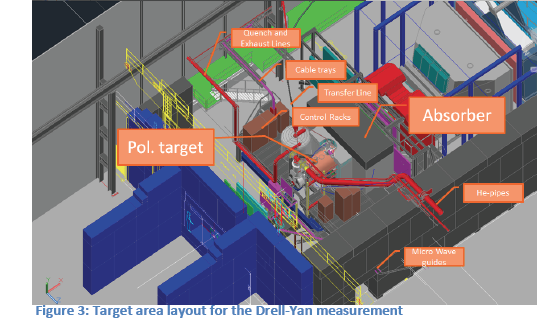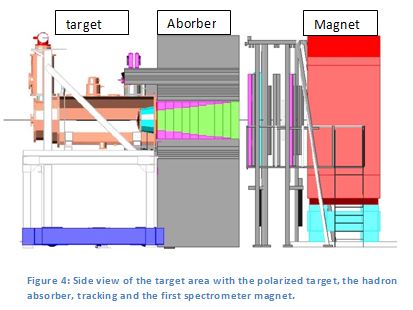COMPASS-‐II: Preparing for the next step
COMPASS (NA58) is preparing for the next step in its programme studying nucleon structure and hadron spectroscopy. From 2014 onward the focus will be on transverse momentum dependent (TMD) parton distribution functions (PDF) and on generalised parton distributions (GPD). Both are related to the intrinsic transverse structure of the nucleon and the orbital angular momentum of quarks inside the nucleon. Till today it remains an unanswered question how quarks and gluons conspire to build up the nucleon spin of ½ ℏ and COMPASS will continue to be a leading contributor to the field.
Before we disembark for the new measurements after the accelerator shutdown, COMPASS will measure in 2012 the electric and magnetic polarizability of the pion and collect for the first time data on the kaon polarizability. These polarizabilitites are fundamental properties of pions/kaons and can be calculated with high precision in Chiral Perturbation Theory – a low energy expansion of QCD. These measurements are difficult and experimental results differ far more than the quoted errors. Since neither a pion nor a kaon target exists the measurement will make use of the meson interaction with the coulomb field of heavy nuclei, nickel in our case (Primakoff scattering). The second part of the 2012 beam time will be devoted to a pilot run for the GPD measurement.
The COMPASS Collaboration comprises about 230 physicists and the experiment is located in EHN2 (888) in the North Area. The highly versatile M2 beam line at the SPS can deliver positive and negative hadron beams up to about 280 GeV and polarized positive and negative muon beams up to 200 GeV. Since 2002 precise measurements of the longitudinal and transverse spin-‐dependent PDF of the nucleon were performed in deep inelastic scattering (DIS) of polarized muons off polarized solid-‐state targets. In particular a large gluon polarization could be excluded, which was proposed following the discovery by the EMC that the quark spins contribute little to the nucleon spin. The important finding in 2010 of a non-‐zero azimuthal Sivers asymmetry in single-‐hadron muo-‐production from a transversely polarized proton target is a prerequisite for the proposed Drell−Yan (DY) measurements in 2014 (see below).
In 2008 and 2009 a huge amount of data on hadron spectroscopy was taken with positive and negative hadron beams and liquid hydrogen and a number of nuclear targets. While the positive beam contains many protons and pions, the negative beam consists almost exclusively of pions. Both beams have a kaon contamination at the per cent level. Beam particles are identified by Cherenkov CEDAR detectors. First results from 2008/9 are very promising. The analysis implies partial wave analyses and acceptance corrections and it is particular difficult to obtain reliable results for waves with small amplitudes. Nevertheless, as a first result from a pilot run in 2004, the observation of a resonance with exotic JPC=1−+ quantum numbers could be published. This resonance is consistent with the highly debated π1(1600).
Two major spectrometer upgrades/modifications are needed for the Phase II of COMPASS. GPDs provide a kind of three dimensional picture of the nucleon, sometimes dubbed nucleon tomography. For example the nucleon’s transverse size can be studied as a function of the longitudinal momentum fraction of the quarks involved in the scattering. Key processes are deeply virtual Compton scattering (DVCS), µp → µp, and hard exclusive meson (h) production (HEMP), µp → µph. These processes imply that the target nucleon stays intact and thus require the detection of the proton in the final state. The large target recoil detector CAMERA (Figure 1) will surround a liquid a 2.5 m long liquid hydrogen target presently being constructed by TE-‐CRG. The photomultiplier signal of CAMERA will be digitized with 1 GHz by the Gandalf board (Figure 2).

The system will allow the detection of recoil protons at least down to a momentum of 300 MeV/c. The electromagnetic calorimeter system has to be modified to achieve full coverage. A new ECAL0 located right downstream of CAMERA will fully cover the enlarged photon acceptance compared to the previous measurement with the polarized target. The towers will be read out by multipixel-‐ avalanche-‐photodiodes. A number of tracking detector will have to be upgraded and made fit for another 5+ year programme. The CAMERA project is let by Saclay, Mainz and Freiburg, while JINR Dubna is leading the ECAL0 project.
The GPD pilot-‐run in 2012 aims to providing first physics data on the DVCS process. The measurement profits from the DVCS interference with the Bethe−Heitler process, which enhances the cross-‐section of the interference term and provides a natural normalisation in kinematic regions where it dominates. The measurement proceeds via the determination of azimuthal cross-‐section asymmetries for positive and negative muons with opposite polarization. The latter is a unique feature of muon beams arising from pion decay. Details can be found in the COMPASS-‐II proposal chap. 1, which was approved in December 2010 in parallel to the GPD programme data will be taken for semi-‐inclusive DIS in order to further constrain the favour decomposition of the spin-‐averaged quark distributions. For these measurements particle identification by the RICH is mandatory. An upgrade of the RICH photon detection is planned by the Trieste group.

During the 2013 shutdown the COMPASS target region will be modified for the first polarized Drell–Yan measurements with a negative pion beam in 2014. This process is dominated by the annihilation of a valence anti-‐u-‐quark of the pion a with a valence u quark of the target proton yielding a µ+µ− pair. Apart from the study of TMD PDFs, which is interesting by itself, one of the main goals is to test the QCD prediction that certain TMD PDFs show a restricted universality: they should change sign when measuring the same TMD PDF in DIS on one hand and in Drell–Yan reactions on the other. The reason for this is that for time-‐reversal odd TMD PDFs, like the Sivers function, the involved gauge link has opposite sign for initial (DIS) and final state (DY) interactions. A violation of this prediction would have far reaching consequences for the calculation of cross-‐sections in QCD. In 2010 COMPASS established that the Sivers asymmetry is non-‐zero for the proton, an observation made earlier by the HERMES Collaboration. However, only at COMPASS energies one can be reasonably sure that higher-‐twist effects are not the origin of this effect. The next step is now to measure the corresponding azimuthal asymmetry in polarized Drell–Yan reactions. Efforts for similar measurements are under way at RHIC and JPARC.

The heart of the setup is the large COMPASS polarized target used up to now only with muon beam. To suppress background and to achieve highest luminosities a sophisticated hadron absorber designed at Turin will be placed downstream of the polarized target. This in turn requires a complete restructuring of the target area, since the target requires a complicated infrastructure like the pump system in an annex building. The new layout is sketched in Figure 3 and Figure 4. The absorber has been dimensioned to achieve acceptable radiation and background levels up to a beam intensity of 109pions per 10 s spill. The main signal region is in the muon pair mass region 4 GeV < M µµ< 9 GeV beyond the J/ψ resonance. Detailed event rate simulations can be found in the COMPASS-‐II proposal, chap. 3. A determination of the above mentioned relative sign change between DIS and DY reactions will be achieved in 2014. To obtain more information about the shape of the TMD PDF more measurements will be required.
The COMPASS schedule after the 2013 shutdown starts with DY measurements using a negative pion beam and the polarized target in 2014 followed by two years of GPD-‐related measurements with muon beams and a liquid hydrogen target. Beyond 2016 we consider further DY measurements and GPD-‐related measurements with a polarized target. Depending on the findings from the spectroscopy data it might be highly desirable to also perform more detailed experiments in this sector.
COMPASS will enrich the CERN non-‐LHC programme also in the years to come thanks to the support of our funding agencies and CERN, in particular from the TE, EN, DGS-‐RP and PH departments and groups.
